COPYRIGHT, PLEASE NOTE
All the material on this website is copyrighted to J-P Metsavainio, if not otherwise stated. Any content on this website may not be reproduced without the author’s permission.
BUY A MUSEUM QUALITY POSTER
BUY A POSTER:https://astroanarchy.zenfolio.com/
Sunday, March 9, 2008
M13, second tryout
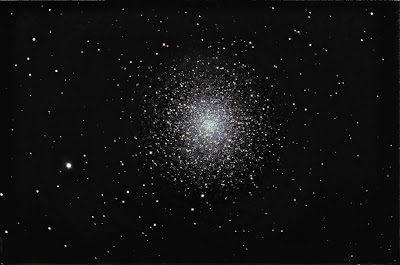
Gropped area from M13. The extended exposuretime reveals more and more dim stars around
the core.
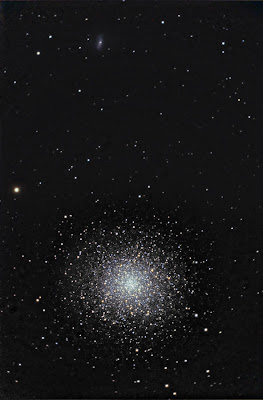

After I was shooting Sh2-240, I moved to M13.
This is a second tryout at this season.
Weather was ok to shoot with 200mm lens, but with2000mm situation was different.
Very bad seeing and since I shoot from very center of the city, there was lots of heat current from buildings.
M13 altitude was between 30 and 45degrees. Moust of the frames are shooted trough not so thin clouds.
This time I composed image so, that I was able to placea litle galaxy, NGC 6207, at the same field of view.
There is 5 x 10min and 11 x 5min, unfiltered subs used in the image.I allso add lights from previous tryout, 7 x 15min, IDA filter. Total exp. time is three and half hours.Camera: QHY8, telescope: LX200 GPS 12", Guiding: SXV-AO+LodeStar.
Image is scaled down
Ps.
The "Shadows and Highlights" tool under Photoshop is great for targets like this!
I can pull out dimmer stars as much as I like without blowing up the core.
Saturday, March 8, 2008
Sh2-240, four more hours.
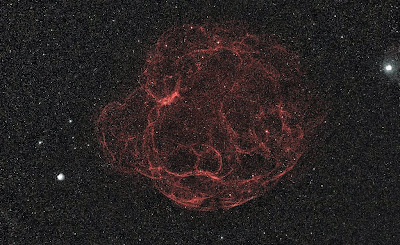
This is a false color image of the Sh2-240.
Image of the object with no stars was added as lighten mode to the Red channel,
under PS.
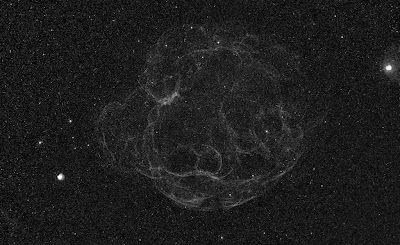

h-alpha image.
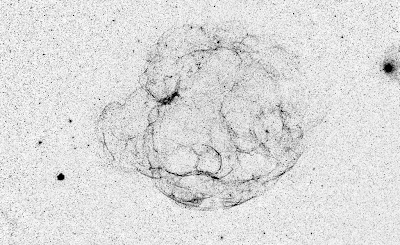 Inverted version
This is a version with no stars (image processing trick)
to bring out the structure better. This image was used to make a false color image.
Inverted version
This is a version with no stars (image processing trick)
to bring out the structure better. This image was used to make a false color image.
This is really difficult target!
I can see effects of light pollution here, even with 7nm H-a
filter. Bad gradients etc...
This time I shooted 4 X 3600s = One hour subs!
My record so far. Longer subs are needed to bring out very
faint structure of this object.
So far there is about 7h exposures, I thin an other 10 hous is needed here.
I'll shoot more when weather allows.
 Inverted version
Inverted version
Labels:
Canon FD 200mm f2.8 images,
nebula
Thursday, March 6, 2008
Sh2-240 (Simeis 147)

this is a start of the long project.
my goal is to capture enough photons from this dim object to
be able to reveal its beauty.
This is a supernova remant in Taurus & Auriga.
The angular diameter of the object is huge, about 200'x180'!
Thats about 8 full Moon diameters. Doe the large size
the surfage brightness is very low, I think, I'll need least
20 hours of exposures to capture this well.
Last night I had problems with frost and I was not able to see
it before image processing. All the frames are practically useless.
You can see big bloated stars, even in small image.
How ever, I put small image here just for example.
There is both normal H-alpha image and inverted one.
exposures ( with frost in optics)
4 x 2700 s
3 x 900 s
FD 200mm f2.8 lens, QHY8, guiding QHY5 and LX200 GPS 12"
(This large object and the 200mm lens are very good match.)
Labels:
Canon FD 200mm f2.8 images,
nebula
Friday, February 29, 2008
Litle test, jus for fun

This is a sample about 3D-transform.
In the left side image the great galaxy of Andromeda is seen as normally.
On the right side image the same galaxy is twisted,
so that you are able to see it as seen from above.
Original image was not very high quality, but even tough, more
general structure can be seen in this manner.
It looks like the spiral structure is more visible in the right hand image.
I'll like to try this to some high resolution, nearly on edge galaxy, later.
I did this tarnsform under PhotoShop this time. by
using simple tretch.
Better results can be archived with real 3D-software, where I can project the image
to a real 3D-surface and rotate it to an any angle i like.´I'll try that later.
Labels:
research and development
Thursday, February 28, 2008
The Great Globular Cluster in Hercules, M13

M13 image is from 27.02., same night as previous IC 405 & IC 405 image.
Picture is scaled down about 50%
This one was hard to process doe massive light pollution defects,
gradient, LP noise and weak S/N ratio.
Imaging telescope:
LX200 gps 12" @ f6.3
Guiding:
SXV-AO @ 10Hz
Cameras:
QHY8 for imaging
Lodestar for guiding
Filter:
IDAS LP
Exposures:
9 X 900s = 2h 15min.
UPDATE
I did a new version.
This time I skipped two frames doe the bad quality.
Now there is 7x900s.
I also used CCDStack positive Constrain deconvolution,33 iterations.
Images are updated.
Wednesday, February 27, 2008
IC 405 & IC410
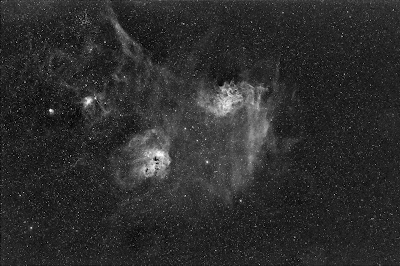
Flaming Star nebula and its companion forms a beautiful pair.
Image is quite deep doe the fast 200mm f2.8 lens and three hours of exposures,
there is lots of nebulosity visible around main objects.
I'll shoot color for this later.
This is a emission nebula but in the Flaming Star part there should be
som bluish reflection nebulosity as well, lets see if I'm able to pick it up.
I had a lot of technical problems last night. There is a heater strip in the camera assembly to prevent dewing. In some state I managed to destroy the power plug.
I can tell, it's not a nice job to do soldering at snow with freezing wind and darkness.
After that I dropped some essential parts in the deep snow and did spend an hour to looking for them.
Image info:
Canon FD 200mm f2.8 lens coupled with QHY8 6mb cooled color camera.
7nm H-alpha filter
Exposures 9 x 1200s = 3 hours
Guiding and platform LX200 GPS 12" with QHY5 guider.
Processing in CCDStack and PS.
Monday, February 25, 2008
NGC 2683 "Sanp shot"

This is a dim galaxy in constellation Lynx.
I managed to capture less than two hours of data before
the clouds rolled in.
There is some details visible in the core.
LX200 GPS 12" and QHY8
Guided with SXV-AO and LodeStar camera
IDAS LP filter
10 x 660s + Flats and Bias frames
IRIS Drizzle function was used to bring out some details.
(Light pollution more or les destroy this image.)
Tuesday, February 19, 2008
Horse head nebula, IC 434

I'm not happy with this image at all, but since
I finally managed to capture this nebula with some color I put it here.
Up here the maximum elevation for IC 434 is about 21 degree and when target is in its moust Southern point, the view is blocked by the buildings.
That means lots of turbulent air between target and telescope.
When I was shooting the RGB channels, target was only 10 degrees abowe horizont.
There is a way too few exposures for this relatively dimm object, only two hours of H-a.
6 x 1200s for H-alpha and 4 x 660s for RGB channels with IDAS LP filter.
Actually I shoot half of the frames between neon signs at top of the opposite building.
Telescope LX200 GPS 12" @ f6.3
Camera QHY8
Guiding SXV-AO, active optics unit.
 Here is the H-alpha channel only
Here is the H-alpha channel only
Subscribe to:
Posts (Atom)










